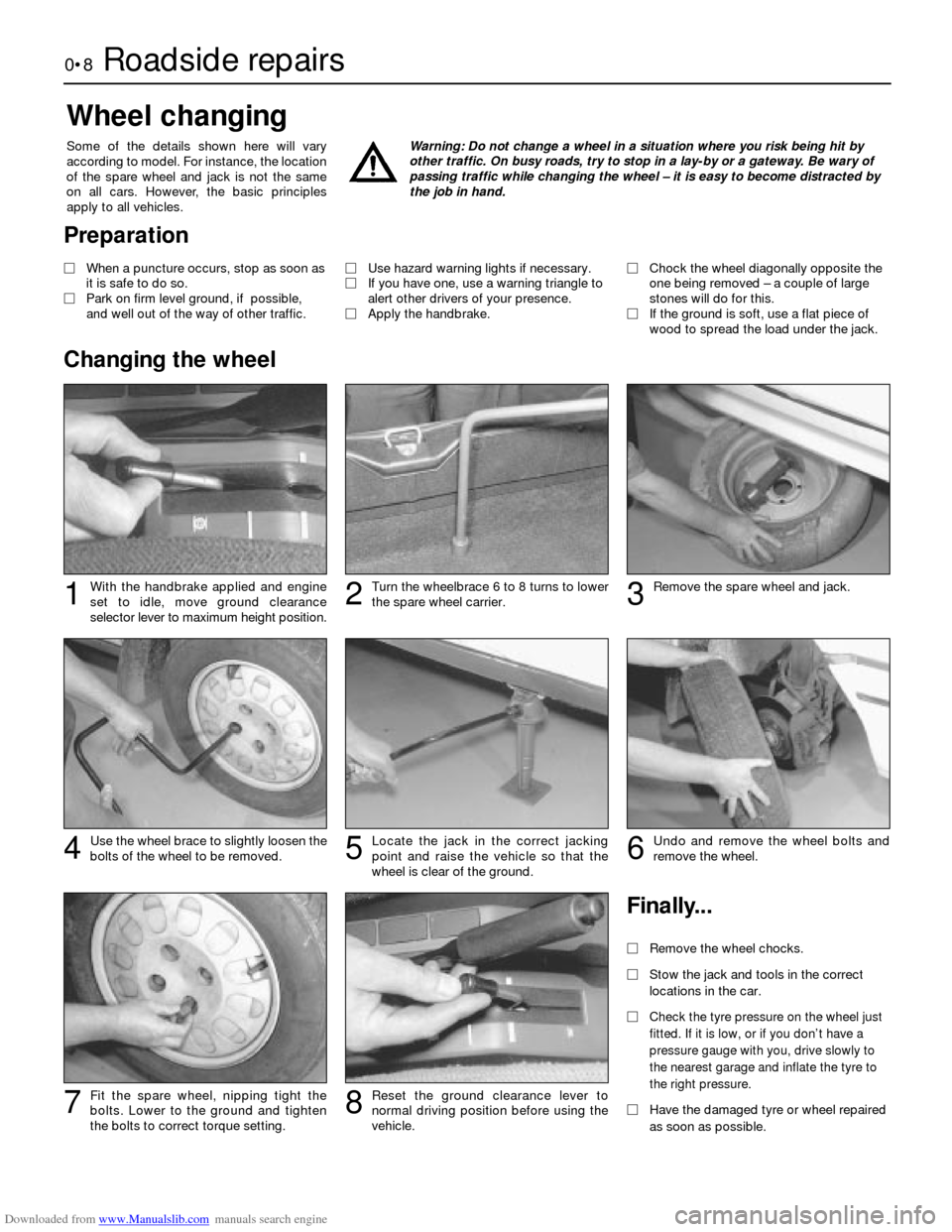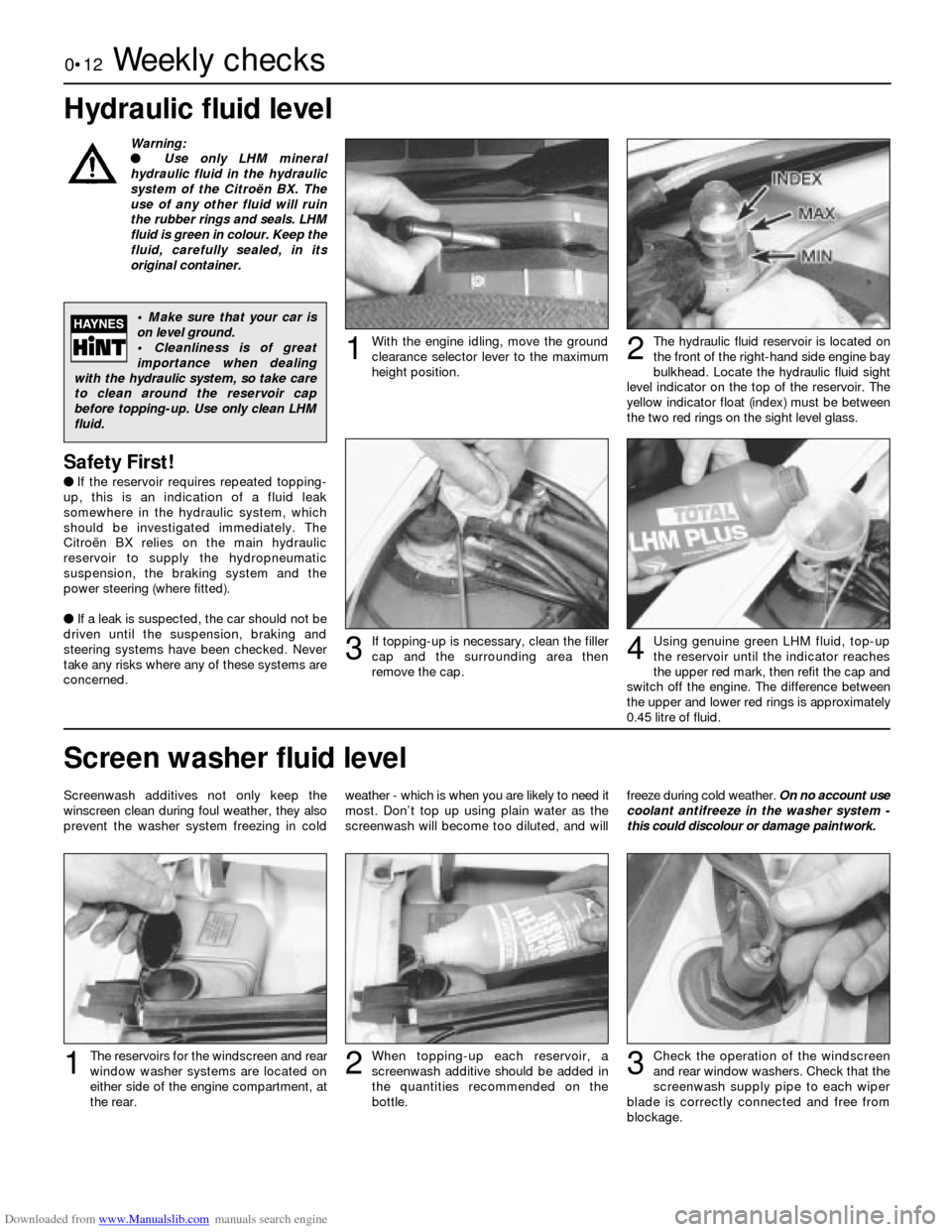ground clearance Citroen BX HATCHBACK 1992 2.G Workshop Manual
[x] Cancel search | Manufacturer: CITROEN, Model Year: 1992, Model line: BX HATCHBACK, Model: Citroen BX HATCHBACK 1992 2.GPages: 16, PDF Size: 0.47 MB
Page 4 of 16

Downloaded from www.Manualslib.com manuals search engine The Citroën BX was introduced in France in October of 1982 and
became available in the UK in September 1983. The original models
available in the range were the BX, BX 14 E, BX 14 RE, BX 16 RS and BX
16 TRS. The types of engine, transmission and equipment fitted being
dependent on the model and the body design being that of a Hatchback.
For the 1985 model year, the BX 19 GT was made available for the
driver requiring a higher performance model. Also in 1985, the BX
Leader replaced the BX and BX 14 models, the Leader being fitted with
the same engine and transmission as the BX 14. In the second half of
1985 the Estate was introduced, two versions being available, the BX
16 RS Estate and the BX 16 TRS Estate.
Changes for the 1987 model year included the introduction of the BX
16 RE Hatchback, the BX 19 GTi (fuel injection and ABS braking), the
BX 19 GTi 16v (16 valve engine) and the replacement for the BX 19 GT,
the BX 19 TRS. Also, a BX 19 TRS Estate fitted with automatic
transmission became available. The facia and instruments were
modified on all models, with round instruments being used. Other
aesthetic improvements were made to improve the external
appearance of certain models.For the 1988 model year, all BX 14 models were equipped with the
K1G engine with 2CA type 4 or 5-speed manual gearbox.
For the 1989 model year, BX 16 and BX 19 models were equipped
with the BE3 5-speed manual gearbox to replace the earlier BE1 5-
speed type.
In early 1990, BX 19 TZi Hatchback and Estate models became
available, these being equipped with catalytic converters.
In late 1992, BX 16 TXi catalytic converter equipped Hatchback and
Estate models were added to the range.
On all models, the engine and transmission is mounted transversely
and drives the front wheels through two driveshafts. The transmission
available (depending on model type) is a 4 or 5-speed manual gearbox
or a 4-speed automatic unit.
All models are extremely comfortable to ride in, thanks to the
hydropneumatic suspension and luxurious interior trim. The unique
design suspension is self-levelling and the ride height is maintained
automatically over all road conditions. A ground clearance lever inside
the car may be used to adjust the ride height when travelling over
rough ground, this also makes changing a roadwheel much simpler.
Your Citroën BX Manual
The aim of this Manual is to help you get the best value from your
vehicle. It can do so in several ways. It can help you decide what work
must be done (even should you choose to get it done by a garage),
provide information on routine maintenance and servicing, and give a
logical course of action and diagnosis when random faults occur.
However, it is hoped that you will use the Manual by tackling the work
yourself. On simpler jobs it may even be quicker than booking the car
into a garage and going there twice, to leave and collect it. Perhaps
most important, a lot of money can be saved by avoiding the costs a
garage must charge to cover its labour and overheads.
The Manual has drawings and descriptions to show the function of
the various components so that their layout can be understood. Then
the tasks are described and photographed in a clear step-by-step
sequence.
Acknowledgements
Thanks are due to Champion Spark Plug who supplied the illustrations
showing spark plug conditions, and to Duckhams Oils, who provided
lubrication data. Certain other illustrations are the copyright of Citroën
(UK) Limited and are used with their permission. Thanks are also due to
Sykes-Pickavant Limited, who supplied some of the workshop tools,
and to all those people at Sparkford who helped in the production of
this Manual.
We take great pride in the accuracy of information given in this
manual, but vehicle manufacturers make alterations and design
changes during the production run of a particular vehicle of which
they do not inform us. No liability can be accepted by the authors
or publishers for loss, damage or injury caused by any errors in, or
omissions from the information given.
0•4Introduction
The Citroën BX Team
Haynes manuals are produced by dedicated and
enthusiastic people working in close co-operation. The
team responsible for the creation of this book included:
Authors Ian Coomber
Christopher Rogers
Sub-editors Sophie Yar
Carole Turk
Editor & Page Make-up Steve Churchill
Bob Jex
Workshop manager Paul Buckland
Photo Scans John Martin
Paul Tanswell
Steve Tanswell
Cover illustration & Line Art Roger Healing
We hope the book will help you to get the maximum
enjoyment from your car. By carrying out routine
maintenance as described you will ensure your car’s
reliability and preserve its resale value.
Citroën BX 19 GTiCitroën BX 16 TRS
Page 8 of 16

Downloaded from www.Manualslib.com manuals search engine 0•8Roadside repairs
With the handbrake applied and engine
set to idle, move ground clearance
selector lever to maximum height position.
Wheel changing
Some of the details shown here will vary
according to model. For instance, the location
of the spare wheel and jack is not the same
on all cars. However, the basic principles
apply to all vehicles.Warning: Do not change a wheel in a situation where you risk being hit by
other traffic. On busy roads, try to stop in a lay-by or a gateway. Be wary of
passing traffic while changing the wheel – it is easy to become distracted by
the job in hand.
Finally...
MRemove the wheel chocks.
MStow the jack and tools in the correct
locations in the car.
M
Check the tyre pressure on the wheel just
fitted. If it is low, or if you don’t have a
pressure gauge with you, drive slowly to
the nearest garage and inflate the tyre to
the right pressure.
MHave the damaged tyre or wheel repaired
as soon as possible.
Use the wheel brace to slightly loosen the
bolts of the wheel to be removed.Locate the jack in the correct jacking
point and raise the vehicle so that the
wheel is clear of the ground.Undo and remove the wheel bolts and
remove the wheel.
Remove the spare wheel and jack.Turn the wheelbrace 6 to 8 turns to lower
the spare wheel carrier.123
4
Fit the spare wheel, nipping tight the
bolts. Lower to the ground and tighten
the bolts to correct torque setting.7Reset the ground clearance lever to
normal driving position before using the
vehicle.8
56
Preparation
MWhen a puncture occurs, stop as soon as
it is safe to do so.
MPark on firm level ground, if possible,
and well out of the way of other traffic.MUse hazard warning lights if necessary.
MIf you have one, use a warning triangle to
alert other drivers of your presence.
MApply the handbrake.MChock the wheel diagonally opposite the
one being removed – a couple of large
stones will do for this.
MIf the ground is soft, use a flat piece of
wood to spread the load under the jack.
Changing the wheel
Page 12 of 16

Downloaded from www.Manualslib.com manuals search engine 0•12Weekly checks
Hydraulic fluid level
Warning:
l Use only LHM mineral
hydraulic fluid in the hydraulic
system of the Citroën BX. The
use of any other fluid will ruin
the rubber rings and seals. LHM
fluid is green in colour. Keep the
fluid, carefully sealed, in its
original container.
Safety First!
lIf the reservoir requires repeated topping-
up, this is an indication of a fluid leak
somewhere in the hydraulic system, which
should be investigated immediately. The
Citroën BX relies on the main hydraulic
reservoir to supply the hydropneumatic
suspension, the braking system and the
power steering (where fitted).
lIf a leak is suspected, the car should not be
driven until the suspension, braking and
steering systems have been checked. Never
take any risks where any of these systems are
concerned.
• Make sure that your car is
on level ground.
• Cleanliness is of great
importance when dealing
with the hydraulic system, so take care
to clean around the reservoir cap
before topping-up. Use only clean LHM
fluid.
With the engine idling, move the ground
clearance selector lever to the maximum
height position.1The hydraulic fluid reservoir is located on
the front of the right-hand side engine bay
bulkhead. Locate the hydraulic fluid sight
level indicator on the top of the reservoir. The
yellow indicator float (index) must be between
the two red rings on the sight level glass.2
If topping-up is necessary, clean the filler
cap and the surrounding area then
remove the cap.3Using genuine green LHM fluid, top-up
the reservoir until the indicator reaches
the upper red mark, then refit the cap and
switch off the engine. The difference between
the upper and lower red rings is approximately
0.45 litre of fluid.4
Screenwash additives not only keep the
winscreen clean during foul weather, they also
prevent the washer system freezing in coldweather - which is when you are likely to need it
most. Don’t top up using plain water as the
screenwash will become too diluted, and willfreeze during cold weather. On no account use
coolant antifreeze in the washer system -
this could discolour or damage paintwork.
Screen washer fluid level
When topping-up each reservoir, a
screenwash additive should be added in
the quantities recommended on the
bottle.2The reservoirs for the windscreen and rear
window washer systems are located on
either side of the engine compartment, at
the rear.1Check the operation of the windscreen
and rear window washers. Check that the
screenwash supply pipe to each wiper
blade is correctly connected and free from
blockage.3